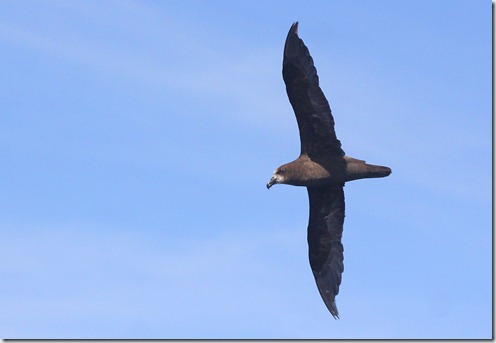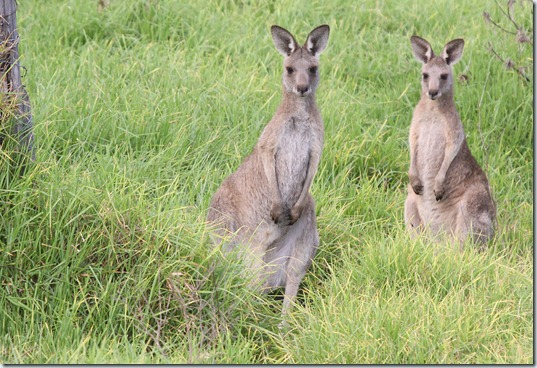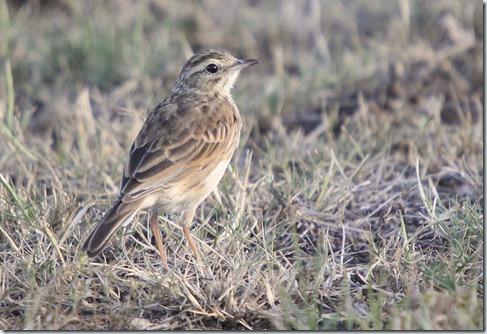





I went back to the waterworks to see if there were any tiny grebes riding on their parent’s backs. There weren’t, grebes were still sitting on nests. It was a beautiful morning to be out, however. Just a touch of coolness in the air hinting that autumn is just a few days away, and perfectly still. I took quite a few shots of ducks, grebes, coots, and their reflections in the glassy water.
It was a day for watching birdwatchers apparently:
 Eastern Grey Kangaroo, Macropus giganteus
Eastern Grey Kangaroo, Macropus giganteus
Grey-headed Flying-fox, Pteropus poliocephalus
Superb Fairywren Malurus cyaneus
Many of the birds in the Hunter Region are in moult at the moment. It is great to watch the visiting waders adopt their breeding plumage before heading back to Siberia – always hoping that one in full colour will pose for a photograph before heading off.
And the local birds are moulting into their basic (or eclipse) plumage at the end of their breeding season. Females, immatures, and non-breeding male Superb Fairywrens are a plain fawn colour with a lighter underbelly. Females and immatures have a fawn tail, while males have a dull greyish blue tail. The bill is brown in females and juveniles and black in males after their first winter. The male in breeding plumage has a striking bright blue forehead, ear coverts, mantle, and tail, with a black mask and black or dark blue throat.
Australian Kestrel Falco cenchroides
The name kestrel is given to several members of the falcon genus, distinguished by their typical hunting behaviour which is to hover over open country and swoop down on prey, usually small mammals, lizards or large insects. Other falcons are more adapted to active hunting on the wing.
Australian Kestrels are often seen hovering over road reserves and paddocks. Once they have their prey in sight, they plunge head first toward the ground, pulling out of their dive at the last moment to strike with their feet.
This female has a regular territory along the river from Kooragang Dykes to Walsh Point.

The early sun was behind this group of Common Terns feeding on a school of small fish in the harbour, so while they aren’t great images for ID purposes, I kind of like the effect.
The species is a non-breeding migrant to Australia, where it is widespread and fairly common on the eastern coast during summer. The subspecies occurring in Australia is predominantly Sterna hirundo longipennis. Reportedly “In non-breeding plumages, adults differ from those in breeding plumage by: white forehead and lores that merge to dirty white and black-streaked crown and black half-cap on the rear crown, nape and ear-coverts, and with a large black patch in front of the eye; pale grey rump merging into white uppertail-coverts; and a conspicuous black cubital bar and a dusky secondary bar on the upperwing and a dusky wedge on the outer upperwing. The underparts are also white. The bill is black, occasionally with a red tinge at the base, and the legs usually black or black faintly tinged with red.”
Common Terns are recorded in Queensland from September, and usually arrive in NSW from late September to October. They leave again in mid-April.
The number of birds wintering in in NSW are thought to be increasing, with greater numbers in some areas where they were previously scarce or absent. For example, in Sydney Harbour National Park, Common Terns were seldom reported before 1970 but more recent counts are typically of up to 60 birds.
Department of the Environment, Water, Heritage and the Arts (2010). Sterna hirundo in Species Profile and Threats Database, Department of the Environment, Water, Heritage and the Arts, Canberra. Available from: http://www.environment.gov.au/sprat. Accessed Tue, 16 Feb 2010 10:02:05 +1100.

We came across a number of birds sunning themselves. A rail was standing with its back to the sun with its feathers rustled up to expose the skin below, noisy miners were in a full sunbathing posture with wings and tail feathers spread out to maximize the area open to the sun. The bronzewing pigeons were lying on one side with one wing raised to the sun. The reasons for sunning, and benefits to the bird are a matter of supposition. Obviously, in many cases the birds get warmth from the sun which reduces the amount of metabolic energy they have to expend in order to maintain a constant body temperature of around 40 degrees C.
However, it's summer here. Some birds do sunbathe in temperatures which are quite hot, and they end up over-heated as they can be seen panting. Therefore, some scientists have theorised that the sun's warmth is important in helping dislodge feather parasites. Others suggest that the ultra-violet in sunlight helps turn some precursor molecule in the preening oil into vitamin D and that the birds need this vitamin. It is known that these precursor molecules exist in preening oil and that ultra-violet light will stimulate the conversion into vitamin D. What is not known is how well this happens on the bird's body and how important the amount of vitamin D created would be to the bird.
I’ve been aware of the Powerful Owls that roost in Blackbutt Reserve for some time, but knowing they are there and seeing them are two different things. Today the mosquitoes were horrendous, I had sprayed with insect repellent but they were biting all of the spots I’d missed and surrounding us in buzzing clouds. We decided to just walk the path through the rainforest and then go somewhere in bug-free sun. When we came across him he was hugging the tree trunk, with branches in front of him, but we edged past to where the light was better and he followed us out along the branch and turned around.
Powerful Owls are Australia’s largest owl, with the male standing around 67cm. It’s a generalist hunter, preying on a range of species depending on what is available. The main prey is Ringtail Possum, but this may be supplemented by other arboreal possums, gliders and bats and occasionally birds such as magpies and currawongs. Ground dwelling mammals are rarely taken.
They are forest dwellers which rely on areas of old growth forests that contain mature, live, hollow bearing eucalypt trees that can be hundreds of years old.
I took my sandwich to Blackbutt Reserve and enjoyed some rare sunshine for an hour, before heading back to work. It was nice to have birds approaching me, rather than flying away too :-)
Little Tern (Big Silver Gull)
Another three or four weeks and we will lose our summer visitors. The godwit are starting to colour up into their breeding plumage, and the little tern are dispersing from their breeding sites.

In what may be part two of the Parasitic Jaeger/Arctic Skua story, a sighting of a Sooty Tern was posted to the HBOC list at around midday on Feb 3rd. Later that day others saw this bird, injured, on the rocks on the breakwall. Next morning there were no sightings of a Sooty Tern well or ill. The Parasitic Jaeger, during its breeding season in the Arctic, feeds on small mammals and passerines, but during its winter off the coast of Australia it gets most of its food by attacking gulls and terns and forcing them to disgorge their stomach contents. This bird may have been the victim of such an attack.
The Sooty Tern is a threatened species. It is a pelagic species that forages offshore and birds are usually only observed onshore during breeding season or when they have been forced there by stormy weather. They are seen more often in the tropics, but follow warm currents southward. (The sea of Newcastle is a balmy 23c at the moment.) They follow migrating tuna, feeding off the fish that the tuna drive to the surface.